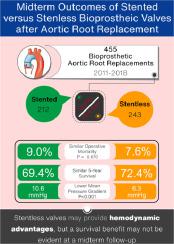Seminars in Thoracic and Cardiovascular Surgery ( IF 2.6 ) Pub Date : 2021-09-11 , DOI: 10.1053/j.semtcvs.2021.09.003 James A Brown 1 , Derek Serna-Gallegos 2 , Arman Kilic 2 , Yancheng Dai 1 , Danny Chu 2 , Forozan Navid 2 , Courtenay Dunn-Lewis 1 , Ibrahim Sultan 2

|
To determine the impact of aortic root replacement (ARR) with a stentless bioprosthetic valve on midterm outcomes compared to a stented bioprosthetic valve-graft conduit. This was an observational study of aortic root operations from 2010 to 2018. All patients with a complete ARR for nonendocarditis reasons were included, while patients undergoing valve-sparing root replacements or primary aortic valve replacement or repair were excluded. Of the patients with a complete ARR, bioprosthetic valve implants were included, while mechanical valve implants were excluded. Patients were dichotomized into the stented ARR group and the stentless ARR group. A total of 1:1 nearest neighbor propensity matching was employed to assess the association of stentless valves with short-term and midterm outcomes. A total of 455 patients underwent a complete ARR with a bioprosthetic valve implant for nonendocarditis reasons, of which 212 (46.6%) received a stented valve, while 243 (53.4%) received a stentless valve. After matching, postoperative outcomes were similar across each group (P > 0.05), including operative mortality and adverse neurologic events. Median follow-up for the entire cohort was 4.41 years (95% CI: 4.01, 4.95). At 1 year follow-up, aortic regurgitation ≥ 2+ and ejection fraction were similar across each group (P > 0.05); however, the stentless valve group had lower aortic valve velocity and transvalvular pressure gradient. Finally, reoperations and survival were similar for each group over the study's follow-up (P > 0.05). Stentless valves may provide hemodynamic benefits after ARR; however, the clinical impact of those benefits for survival and reoperation may not yet be evident in the midterm.
中文翻译:

主动脉根部置换术后支架与无支架生物瓣膜的中期结果
与带支架的生物瓣膜移植导管相比,确定无支架生物瓣膜主动脉根置换术 (ARR) 对中期结果的影响。这是一项关于 2010 年至 2018 年主动脉根部手术的观察性研究。所有因非心内膜炎原因完全 ARR 的患者均被纳入,而接受保留瓣膜根部置换术或原发性主动脉瓣置换术的患者主动脉瓣置换或修复被排除在外。在完全 ARR 的患者中,包括生物瓣膜植入物,而机械瓣膜植入物被排除在外。患者被分为支架 ARR 组和无支架 ARR 组。总共采用 1:1 最近邻倾向匹配来评估无支架瓣膜与短期和中期结果的关联。共有 455 名患者因非心内膜炎原因接受了生物瓣膜植入的完全 ARR,其中 212 名 (46.6%) 接受了支架瓣膜,而 243 名 (53.4%) 接受了无支架瓣膜。匹配后,各组的术后结果相似(P> 0.05),包括手术死亡率和不良神经系统事件。整个队列的中位随访时间为 4.41 年(95% CI:4.01,4.95)。1 年随访时,各组主动脉瓣反流≥ 2+ 和射血分数相似( P > 0.05);然而,无支架瓣膜组的主动脉瓣速度和跨瓣压力梯度较低。最后,在研究的随访期间,每组的再手术率和生存率相似 ( P > 0.05)。无支架瓣膜可在 ARR 后提供血流动力学益处;然而,这些获益对生存和再次手术的临床影响在中期可能还不明显。











































 京公网安备 11010802027423号
京公网安备 11010802027423号